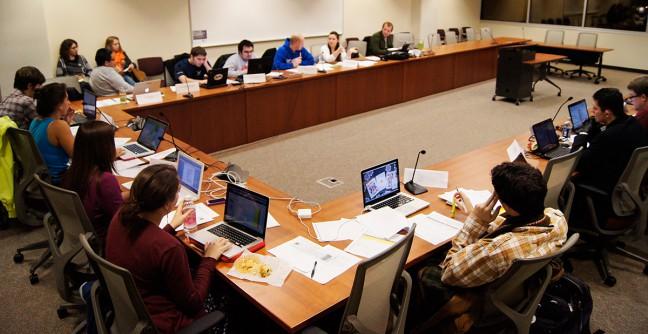The Associated Students of Madison just finished their spring elections, and a new batch of bright-eyed students march off to the soul crushing despair of student government work. The problem is not that the work is unimportant — it’s very important — or that students cannot have an impact on issues they care about — they certainly can. It’s that ASM as an institution is perennially ill-equipped to actually achieve what their candidates set out to do and must settle for middling change that is often lost in the next election cycle.
There are several trends that are easily identified if you looked at the candidate matrix for the candidates in this election. These trends also haven’t changed in the eight ASM spring elections I’ve been through. The university should invest in more green energy. Students need a bigger say with administration. We need more transparency from campus officials in regards to their talks with the Legislature. The state should invest more money into the university. The campus should be safer for students to walk across. Tuition should be free.
None of these ideas are new.
I don’t expect all representatives to have new ideas; government is often a world where you maintain what works and slowly change what doesn’t. However, I do think it’s fair to expect a level of progress each year that can be built upon and maintained. Where are last year’s representatives continuing the great work they’ve done? How is this information being passed on to the new representatives? Our partners in shared governance have the benefit of time. If a student comes to them with a problem, it really is not hard to just delay and obfuscate for a few months or a year and then the student moves on and the committee does not really have to deal with it. We don’t have that luxury.
One reason ASM has difficulty actually achieving its goals is this yearly turnover. ASM’s institutional memory is short and Student Council ought to have longer term limits than just a single year in order to build on previous work. New representatives take time to get up to speed on crucial university operations, and there is simply not enough time to educate, act and achieve results within one term.
Another reason is that many, including those who serve within ASM already, have a fuzzy relationship with segregated fee funding and what it actually costs to do programs. Some representatives will say they want to increase campus safety through additional funding for student organizations and in the same breath advocate for a more affordable experience for students. The Student Services Finance Committee (SSFC) candidates are just as guilty of fuzzy funding logic.
Most of the candidates for SSFC advocated one way or another for more affordable allocation of segregated fees, but this is an insincere concept under the current segregated fee system. Briefly, segregated fees are divided into two groups — allocable and non-allocable. The non-allocable section is larger by far and funds organizations like Rec Sports, University Health Services, and the Wisconsin Union. This year, non-allocables represent nearly $38 million of the $44 million segregated fee budget and are essentially untouchable by students. According to F50, which outlines UW-System policy on segregated fees, students may “review and offer advice” on non-allocable budgets but ultimately, the decision is up to the chancellor.
So with 86 percent of all segregated fees out of the hands of direct student control, how much can our representatives really do to make attendance more affordable? The allocable section of segregated fees is miniscule compared to the funds students send to the Union, Rec Sports or UHS. Without new funding streams from the Legislature or a drastic restructuring of F50 — which I’ll advocate for another day — ASM is working with tied hands.
ASM can make progress and accomplish good work, but there needs to be much better carryover from one term to the next. When I was vice-chair in 2009, we kicked around a potential solution that was never actually implemented. We discussed a creating a public wiki to help keep our current projects transparent and accountable, but the venture never got off the ground. Maybe this new generation of representatives can do it better and see it through.
I challenge the new representatives to build an infrastructure for success. Meet with current leaders and members of ASM to discuss what they’re working on and see if you can maintain the momentum. I challenge outgoing representatives to develop the next term’s leaders during the remainder of your term. Pass on your contacts within the UW and the city for a more seamless transition. Pass off projects with thorough and formal documentation and transition materials.
You can achieve great things but your predecessors, of which I am one, are your biggest obstacle. Help ASM get out of its own way and build an infrastructure for the future.
Adam Johnson ([email protected]) is a masters candidate at the La Follette School of Public Affairs. He was vice-chair of the 17th session of ASM.














